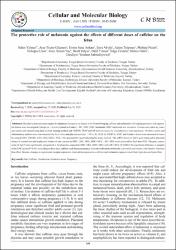The protective role of melatonin against the effects of different doses of caffeine on the fetus

Göster/
Erişim
info:eu-repo/semantics/openAccessTarih
2020Yazar
Yılmaz, SeherGöçmen, Ayşe Yeşim
Arıkan, Evrim Suna
Akyüz, Enes
Tokpınar, Adem
Nisari, Mehtap
Unur, Erdoğan
Yay, Arzu Hanım
Yalçın, Betül
Yılmaz, Halil
Ertekin, Tolga
Güler, Hatice
Sabitaliyevich, Uteuliyev Yerzhan
Üst veri
Tüm öğe kaydını gösterÖzet
Skeletal system and some organs development changes in rat fetuses with 30 and 60 mg/kg caffeine and melatonin's (10 mg/kg) protective role against rat fetuses were investigated. Groups (n = 4) were formed as Control, LDC, HDC, LDC+melatonin, HDC+melatonin and melatonin. Fetuses were taken by cesarean section and stained using dual skeletal staining method and FESEM. TRAP and AP immune-reactivity concentrations were calculated. Oxidative stress and inflammatory markers were also measured by liver, bone and placenta samples. TNT-alpha, IL-1 beta, IL-6, VEGF-A, SOST and Fetuin-A levels were measured in tissue by using ELISA. TBARS, SOD, GSH, GSSG, TOS, TAS, measured by spectrophotometric assay method. The mRNA levels of Agtr2 gene expressed in placental tissues of control rats and in placental tissues of rats exposed to HDC, LDC, MEL, HDC+MEL, LDC+MEL were analyzed by Real-time PCR. The gene expressions of Agtr2 were significantly upregulated in the placentas exposed to HDC. MEL. HDC+MEL and LDC+MEL (P<0,001). No significant difference in samples of the LDC group (P>0,05). According to these data, caffeine used during pregnancy delayed ossification; melatonin, a powerful antioxidant, was found to eliminate this effect. Besides, changes in angiotensin receptor expression observed in response to a caffeine and melatonin exposure result from high dose and join effect.















